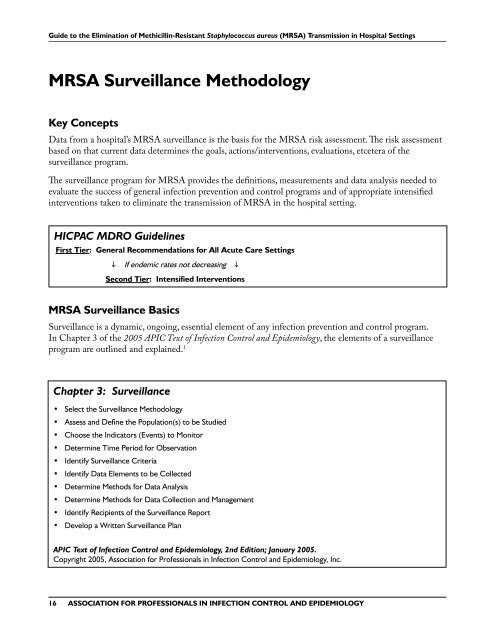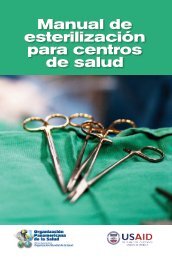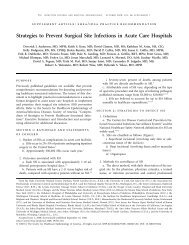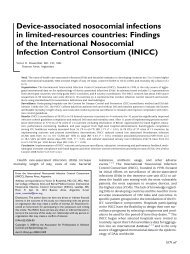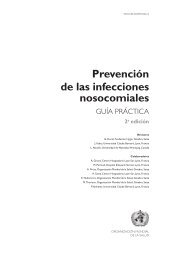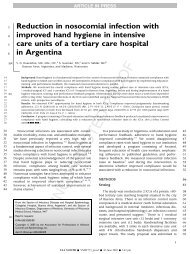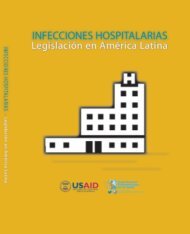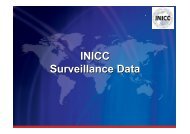Guide to the <strong>Elimination</strong> of Methicillin-Resistant Staphylococcus aureus (<strong>MRSA</strong>) Transmission in Hospital Settings<strong>MRSA</strong> Surveillance MethodologyKey ConceptsData from a hospital’s <strong>MRSA</strong> surveillance is the basis for the <strong>MRSA</strong> risk assessment. The risk assessmentbased on that current data determines the goals, actions/interventions, evaluations, etcetera of thesurveillance program.The surveillance program for <strong>MRSA</strong> provides the definitions, measurements and data analysis needed toevaluate the success of general infection prevention and control programs and of appropriate intensifiedinterventions taken to eliminate the transmission of <strong>MRSA</strong> in the hospital setting.HICPAC MDRO <strong>Guideline</strong>sFirst Tier: General Recommendations for All Acute Care Settings If endemic rates not decreasing Second Tier: Intensified Interventions<strong>MRSA</strong> Surveillance BasicsSurveillance is a dynamic, ongoing, essential element of any infection prevention and control program.In Chapter 3 of the 2005 <strong>APIC</strong> Text of Infection Control and Epidemiology, the elements of a surveillanceprogram are outlined and explained. 1Chapter 3: Surveillance• Select the Surveillance Methodology• Assess and Define the Population(s) to be Studied• Choose the Indicators (Events) to Monitor• Determine Time Period for Observation• Identify Surveillance Criteria• Identify Data Elements to be Collected• Determine Methods for Data Analysis• Determine Methods for Data Collection and Management• Identify Recipients of the Surveillance Report• Develop a Written Surveillance Plan<strong>APIC</strong> Text of Infection Control and Epidemiology, 2nd Edition; January 2005.Copyright 2005, Association for Professionals in Infection Control and Epidemiology, Inc.16ASSOCIATION FOR PROFESSIONALS IN INFECTION CONTROL AND EPIDEMIOLOGY
Guide to the <strong>Elimination</strong> of Methicillin-Resistant Staphylococcus aureus (<strong>MRSA</strong>) Transmission in Hospital Settings<strong>MRSA</strong> surveillance methodology is targeted (focused) surveillance. The population studied is identifiedand modified as directed by the <strong>MRSA</strong> risk assessment. The indicator to monitor is <strong>MRSA</strong> infection andcolonization in the identified populations. The time period must be sufficient to accrue adequate number ofcases for a valid analysis.Surveillance criteria are the definitions of the numerator and denominator for the rate calculations. Theymust be clear and consistent throughout the surveillance period. If definitions do change, surveillance maybe affected and rates may not be directly comparable to the historical data. Examples of changes that couldaffect surveillance include, institution of a new active surveillance culture program, introduction of a newpatient population or service line, closure or merging of a patient unit, and/or change in the sensitivityor specificity of <strong>MRSA</strong> testing methods. Evaluation of <strong>MRSA</strong> surveillance must take into account anychanges that have occurred.Data elements collected include information that is useful in characterizing <strong>MRSA</strong> cases. This includespatient age and sex, admission date, patient location(s) during admission, prior <strong>MRSA</strong> history, dates ofprior hospitalization, culture date(s), culture source(s), antibiotic susceptibility patterns and presence ofknown <strong>MRSA</strong> risk factors as published in the literature (see “Risk Assessment” section).Additional information that may be collected for <strong>MRSA</strong> surveillance includes procedures or surgeriesperformed, use of invasive devices, underlying conditions and diseases, colonization status (if known),and clinical signs and symptoms of infection. Information related to known or suspected <strong>MRSA</strong> riskfactors for a certain geographic region or demographic population (e.g., inmates of correctional facilities, 2veterinary clinic personnel, 3 hemodialysis patients, 4 etc.) should also be collected. 5Methods of data collection may be real-time (data mining) or retrospective, but should always be afunction of identification of <strong>MRSA</strong> from clinical culture and of <strong>MRSA</strong> from surveillance culture or PCRtesting (i.e., routine surveillance or enhanced surveillance, if performed).Surveillance Data ManagementMethods of data management, analysis and report evaluation include the following essentials:1. Define the data required for prevalence, incidence and transmission calculations.Prevalence: number of patients infected/colonized with <strong>MRSA</strong> divided by the number of patients in the studypopulation at a particular point in timeIncidence: number of new <strong>MRSA</strong> cases divided by the number of people being studied<strong>MRSA</strong> transmission rate on a clinical unit: number of new <strong>MRSA</strong> positive patients divided by the number of patientdays times 1,000 (<strong>MRSA</strong> cases / 1,000 patient days)Examples of Numerator Data: number of new <strong>MRSA</strong> cases; number of <strong>MRSA</strong>-positivepatients at a given point in time (e.g., on admission, on Mondays, on transfer out of a unit,etc); number of <strong>MRSA</strong>-positive infections (clinical culture); number of <strong>MRSA</strong> colonizations(surveillance culture).ASSOCIATION FOR PROFESSIONALS IN INFECTION CONTROL AND EPIDEMIOLOGY 17


